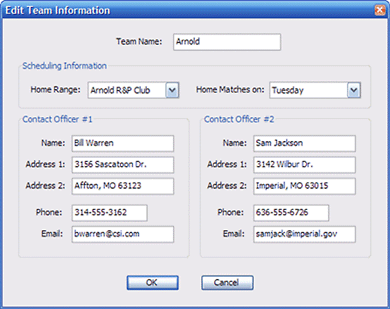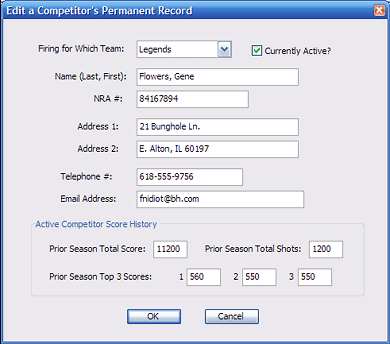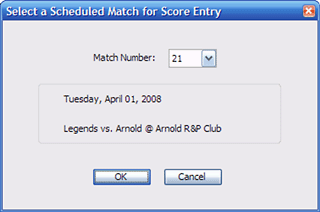LEAGUE ACCESS™ League Administration System
A. Introduction
League Access™ is a versatile application for the scorekeeping and statistics administration of a shooting league, either handicapped or not. Because it was designed to be flexible for adaptability to any shot-value-based discipline, along with a variety of different handicap systems from which to choose, it is a bit complicated for the new user to set up. Fear not, it is easier to use than you might think and this help documentation should help you make the transition quickly and easily. Regardless, if you still get lost despite this extensive documentation, you may always contact the programmer himself via email...
B. The Chronological Menu System
The League Access™ user interface was designed so that menus would be called upon in the order that functions would be needed. The four primary menus of operation are:
I. Setup
The functions where the league is constructed are located in
the Setup menu. The basic framework of the league is formed in the
“League Parameters Setup.
II. Schedule
You will find the functions to create, modify and generate reports for your League season schedule all within the Schedule menu.
III. Weekly
All the functions that you will need during the course of
the season can be accessed from the Weekly menu.
IV. Conclusion
All season-end reporting functions are located within the Conclusion menu. In addition, the final procedure of the season, to “Roll-over to a New Season” is also located here.
C. Setting up the League Structure
I. Step One: League Parameters Setup
In the “League Parameters Setup” mode you really mold the shape of League Access™ to fit your League Program. Organized well by parameter type, the various controls are easy to understand and use. All of these Parameters may be saved and reloaded later in a single configuration file, options within the File menu, “Save” or “Load Configuration.”

The simplest of information to provide, it is important because it will be printed at the top of all reports. Requested information includes: the League’s Official Name, the Season (most likely the year), and the Discipline.
b. Designing Your League Structure
Before you just dive in and start making changes to the Tournament Design screen, you must do a little planning. There are four types of elements that you may construct together to build a competition:
(1) Fired Stages or Matches – Comprised of the scores fired on one or more Targets (i.e. Slow Fire Match, Rapid Fire Prone, etc.)
(2) Sub-Aggregate Matches – A sum score of a group of Fired Stages or Matches (i.e. .22 Caliber Match, etc.)
(3) Aggregate Match – The sum of ALL Fired Stages/Matches added together
(4) Handicap Matches – A handicap score is computed using the Aggregate Match and Competitor Averages
League Access™ requires that you construct your competition in a certain way. To better understand how these matches are organized into a competition, let’s analyze the structure of a typical competition from a weekly league visually in a diagram form:

In order for the summing process to work automatically, notice that Fired Stages/Matches must directly precede the optional Sub-Aggregate Matches that sum them up. The Aggregate Match should follow the last Sub-Aggregate Match if used. Additionally, the optional Handicap Match should be the LAST match of the arrangement. To make your league fit this protocol, it may be necessary to set up your configuration in a slightly different order than it is actually fired.
c. Team Scorekeeping and Standings Setting
This category setting allows you to select one of two ways to handle the scorekeeping of your league. These are:
(1) The worlds of “scratch” and “handicap” are kept apart. “Scratch” is defined as the AGGREGATE match and “handicap” as the HANDICAP match. The entire season is fired to conclude a champion for both categories SEPARATELY, based on the number of team wins and losses in each category. Thus, there are two team “winners” at the end of the season, one scratch champion and one handicap champion.
(2) All fired and aggregate
matches, including handicap, are combined TOGETHER. Point values are
assigned to each match, including handicap, and these points are summed to
decide a team match winner. Instead of just wins and losses, the TEAM
POINTS are summed to decide the season team champion. Thus, there is only one
team “winner” for the season.
d. Handicap Match Parameters
This category allows you to make some important decisions about the processing of the handicap match.
(1) The Handicap Calculation System. You may select from one of four different systems:
|
|
The NRA “Drop-Point” Handicap System: This mathematical handicap system was developed in the 1950’s by Olin Engineer Herman Bockstruck. Its use was popularized when it was published in the NRA’s Sanctioned League Handbook. It remains the most popular system of handicapping leagues for all disciplines of the shooting sports.
|
|
|
Boeing Employees Rifle & Pistol Club: In 2001, Boeing Engineer John Hrenak initiated a project to improve upon the NRA-Olin system. He created a handicap model from scratch to achieve similar exponential-type results but with a flatter “curve” to give the Sharpshooter-level shooter a greater advantage. An improvement? Maybe.
|
|
|
The United Kingdom National Rifle Association’s McRae Handicap System: This is quite probably the first exponential-type handicapping system ever used in shooting competition. Its formula is simple and its “curve” is practical. While similar systems exist, the McRae system is the most popular handicapping method used today in the UK.
|
|
|
The United States Bowling Congress System: While this is the Universal system of handicapping for bowling leagues all across the country, it can also work fairly well for shooting leagues. Its mathematic scoring “curve” is possibly the flattest of all four systems but still provides the higher class shooters an opportunity to compete.
|
(2) The Average Calculation Method. You may decide how to compute the “Average” figure for the Handicap formula:
a. Consider the average of all matches fired throughout the current and past season
b. Consider the average of all matches fired throughout only the current season
c. Take the average of the top-three matches fired during the current and past season
In regards to selecting a handicap calculation system, the four that are utilized appear to be the most popular in the shooting sports world. The formulae of the various handicap systems create a “curve” of values, ranging from the “steepest” with system A to the “flattest” with system D. “Steeper” curve systems better address the fact that firing x amount of points over your average is harder when your average is higher.
The “average” model used for the computation of handicap is also a preference issue. Most often, leagues use the “real” average of a competitor, that is the average of all of his matches from the current and previous season together. However, a popular anti-sandbagging technique is also used extensively – consider only the TOP THREE scores to compute a competitor’s average. Whichever you decide, you’re covered.
II. Step Two: Range Information
In the Range Information mode, you can modify information for the various league ranges, numbered 1 through 12. Move the mouse pointer to any of the 12 lines and DOUBLE-CLICK. This will bring up the “Edit Range Information” dialog box. Be sure to enter all of the requested data:

III. Step Three: Team Information
In the Team Information mode, you can modify information for the various league teams, also numbered 1 through 12. Move the mouse pointer to any of the 12 lines and DOUBLE-CLICK. This will bring up the “Edit Team Information” dialog box. Be sure to enter all of the requested data:

IV. Step Four: Competitor Information
In the Competitor Information mode, you can modify information for any league competitor. To create a new competitor record, find the first available blank line. To edit an existing competitor record, find the competitor in question. In either case, move the pointer to any of the lines and DOUBLE-CLICK. This will bring up the “Edit a Competitor’s Permanent Record” dialog box.

Some information in the dialog box is absolutely CRITICAL. First and foremost is getting the TEAM correct. In addition, if you are setting up this software for an existing league, you will need to have available the data for the “Competitor Score History” section.
D. Creating the League Schedule
I. Create/Edit a League Schedule
A complete schedule for the league is mandatory for the score entry functions to work. You may select “View/Edit Season Schedule” to begin the Season Edit mode, the screen where you may view and edit the schedule database. You may create your schedule from scratch, entering the required data one element at a time. In addition, you may edit it at any time from this same screen. However, once a match is fired and score data entered, you may NOT change the schedule information that refers to that match. A quicker and more accurate approach to creating your season schedule will probably be the...
II. Magic Schedule™ Automatic Schedule Creator
Provided that all of the Range and Team information has been provided correctly, you may create a League Schedule automatically with the single click of a mouse! There is one assumption only, that a team will fire no more than one match per week. The other possibilities are many and are selectable from a handful of controls within the Magic Schedule™ Creation screen as shown here:

Once you get the settings the way you like, click the “Create Schedule” button. As long as there are no errors, a dialog box will pop up within a few seconds indicating that the schedule is ready and that you may save it to the schedule database. If you do elect to save it, any schedule information already in the database will be overwritten.
E. The Weekly League Operations
I. Enter Match
Scores
Select “Enter Match Scores” from the Weekly menu and
you’re ready to select a match to begin entering score data.
Immediately, the Match Selector dialog box will pop onto the screen and you
must use the “Match Number” pulldown selector to choose the desired
scheduled match, as shown here:

Once a match is selected, you go directly into the “Score Entry Mode.” In this mode, the menus up top are disabled and all functions are controlled by the three buttons near the top left of the screen. The Score Entry Mode starts “blank” for the selected match and you have to add competitors one by one, along with their score data.
To add a competitor to the screen, point the mouse in one of those “blank” rows within the competitor “Name” column and DOUBLE-CLICK. This will bring up the “Select Competitor” dialog box shown below:

Once a competitor is selected, his identification information automatically populates the first few rows. FIRED Score data is typed directly into the empty cells to the right for the particular Fired Stages/Matches indicated:

It makes no difference what order competitors are added – organized by team, alphabetically, completely random, or otherwise – the match outcome will be same. The score data must be entered in a strict format based on whether X-Counts are utilized by the discipline in question:
Disciplines using “X-Counts” or “Center Shots” for tie-breaking:
The scores are entered in the format “000.00” with the score on the left side of the period and the 2 DIGIT x-count on the right. A score of 195-7x would be entered as 195.07 and a score of 200-20x is entered as 200.20
Disciplines that do not use X-Counts for tie-breaking:
The scores are simply entered as integers. A score of 97 is entered as 97, but will appear in the cell as “97.00” after you hit ENTER. However, additionally a two-digit tie-breaking figure can be entered right of the decimal point. For example, in skeet shooting, if a competitor fires a score of 22 in a 25-bird match with 16 consecutive targets broken, you could incorporate the system to enter the score as 22.16
The data is examined as you type it and will prompt you if
something does not look right. For example, if a particular Fired Stage
or Match was set up to have 20 shots and you enter a score of 220, you’ll
be informed that it is impossible. Likewise a score of 199-20x will
produce an error message, more X’s than possible.
In addition, the data is further analyzed to create a “checksum” for errors. As you enter a score for a Fired Stage or Match that is the last assigned to a Sub- or Aggregate Match, the total for that Aggregate Match is shown in the status bar at the bottom of the screen. With a single glance, you can compare this figure to that on the competitor’s scorecard to double-check both the scorer’s addition and the accuracy of your entries.
Now that we have discussed the entry of Score Data, we should turn our attention to the three “Function” buttons near the top of the screen. They are:
- Calculate
Once all of the scores from competitors of BOTH teams are entered, clicking the Calculate button will do just that – all of the score data will be instantly processed. The columns expand and are populated with sub- and aggregate totals as well as handicap scores. The team totals are then compiled and the match outcome in all categories is tabulated. In a matter of seconds, an almost imaginable number of database queries and complex calculations take place to make this happen.
- Save
After looking over the score data after it is calculated, you must decide if it is complete and accurate. If you are satisfied with the results as shown, you may click the Save button to post all the individual and team scores into the database. By the way, you cannot Save a collection of match data before Calculating it.
- Cancel
To abort the score entry process entirely and discard any scores entered or totals computed, click the Cancel button. All data will be lost.
II. Create a Match Results Report
The function allows you to create a concise Match Bulletin with ranked competitors and team winners with point assignments for any match that has been recorded throughout the season. Immediately, the familiar Match Selector dialog box will pop onto the screen and you must use the “Match Number” pulldown selector to choose the desired scheduled match, just as when selecting a match to enter the score data.
III. Create a League Statistics Report
This function allows you to create an up-to-date league statistics report. In addition to team standings, you will find individual competitor average statistics as well.
IV. Create a Competitor Records Report
Similar to the League Statistics Report, this function will compile all of the competitors’ highest-fired score statistics for the current season.
V. Create an Updated Competitor Averages Report
You may provide all of the League Teams updated averages from their competitors based on the scores received from the current week. These averages will be used to compute handicaps for the upcoming week.
F. Conclusion of Season Functions
I. Print the NRA
League Score Reporting Form (SR-1 or 2 compliant)
Selecting the “NRA League Score Reporting” function creates the
“League Score Reporting” form. This concise score summary report
should be printed and submitted to the NRA within 30 days of the conclusion of
an NRA-Sanctioned League (or to the sanctioning body of other-type
leagues.)
II. Print
the NRA “Sanctioned League Fee and Entry Report Form”
Selecting the “NRA League Fee and Entry Report” function creates
the “Sanctioned Fee and Entry Report” form. Along with the
Score Report form mentioned above, this required report should be printed and
submitted to the NRA within 30 days of the conclusion of an NRA-Sanctioned
League. The report is populated with information automatically,
indicating how many competitors fired for record over the course of the season
and summing up their $7.00 entry fees to make a single figure for remittance.
III. Print the
Competitor Season Summary Data Report
Selecting the “Competitor Season Summary” function creates a
summary report for all of the competitors who fired for record over the course
of the season. Sorted by team, the report lists the following
information:
a. Competitor Name
b. Top 3 Aggregate Scores
c. Season Aggregate Average
IV. Roll Over to Start a New Season
Selecting the “Roll Over to Start a New Season” function is the
final task in the season bookkeeping process. A competitor’s
previous season totals and averages are replaced with the current
season’s. Then, the league schedule and all score data are
erased making the program ready for the upcoming season.
These changes are FINAL and cannot be undone! Be sure all of the end-of-season reporting has been completed PRIOR to “Rolling Over.”
League Access™ Helpfile release 1.0 on 2/20/08 Helpfile.htm



